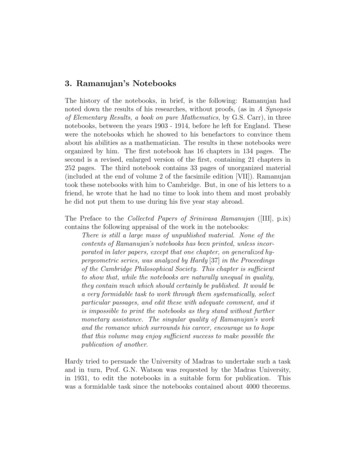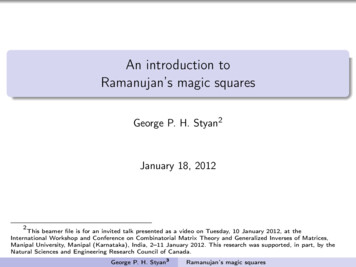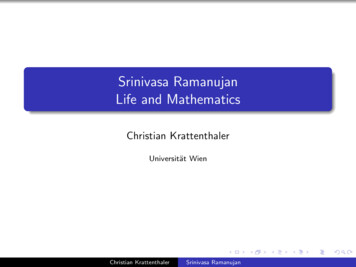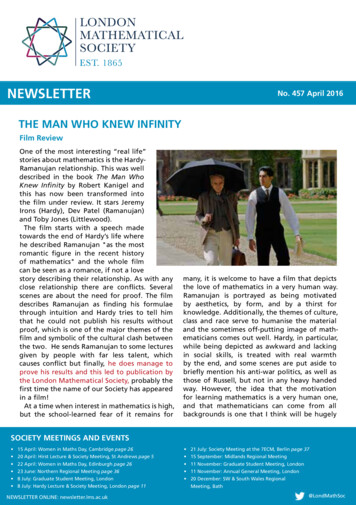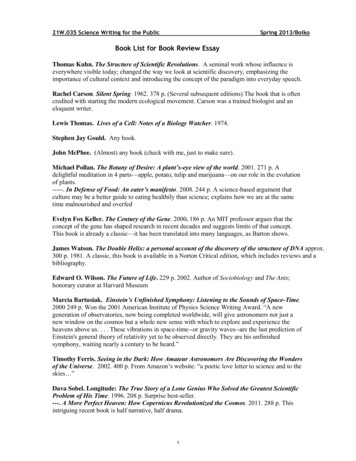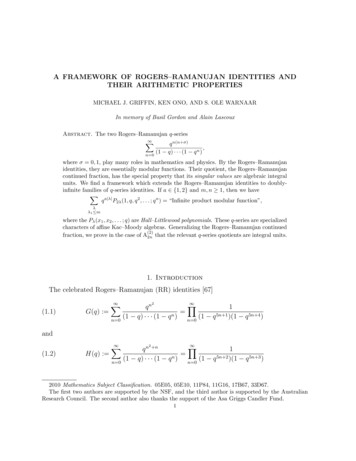
Transcription
A FRAMEWORK OF ROGERS–RAMANUJAN IDENTITIES ANDTHEIR ARITHMETIC PROPERTIESMICHAEL J. GRIFFIN, KEN ONO, AND S. OLE WARNAARIn memory of Basil Gordon and Alain LascouxAbstract. The two Rogers–Ramanujan q-series Xq n(n σ),(1 q) · · · (1 q n )n 0where σ 0, 1, play many roles in mathematics and physics. By the Rogers–Ramanujanidentities, they are essentially modular functions. Their quotient, the Rogers–Ramanujancontinued fraction, has the special property that its singular values are algebraic integralunits. We find a framework which extends the Rogers–Ramanujan identities to doublyinfinite families of q-series identities. If a {1, 2} and m, n 1, then we haveXq a λ P2λ (1, q, q 2 , . . . ; q n ) “Infinite product modular function”,λλ1 mwhere the Pλ (x1 , x2 , . . . ; q) are Hall–Littlewood polynomials. These q-series are specializedcharacters of affine Kac–Moody algebras. Generalizing the Rogers–Ramanujan continued(2)fraction, we prove in the case of A2n that the relevant q-series quotients are integral units.1. IntroductionThe celebrated Rogers–Ramanujan (RR) identities [67](1.1)G(q) : Xn 02 Y1qn n5n 1(1 q) · · · (1 q ) n 0 (1 q)(1 q 5n 4 )and(1.2)H(q) : Xn 02 Yq n n1 n5n 2(1 q) · · · (1 q ) n 0 (1 q)(1 q 5n 3 )2010 Mathematics Subject Classification. 05E05, 05E10, 11P84, 11G16, 17B67, 33D67.The first two authors are supported by the NSF, and the third author is supported by the AustralianResearch Council. The second author also thanks the support of the Asa Griggs Candler Fund.1
2MICHAEL J. GRIFFIN, KEN ONO, AND S. OLE WARNAARplay many roles in mathematics and physics. They are essentially modular functions, andtheir ratio H(q)/G(q) is the famous Rogers–Ramanujan q-continued fraction(1.3)H(q) G(q)1.q1 1 q21 q3. The golden ratio φ satisfies H(1)/G(1) 1/φ ( 1 5)/2. Ramanujan amazinglycomputed further values such as1s 2π H(e 2π )5 55 1 (1.4)e 5 · . 2πG(e )22The minimal polynomial of this value isx4 2x3 6x2 2x 1,which shows that it is an algebraic integral unit. All of Ramanujan’s evaluations are suchunits.Ramanujan’s evaluations inspired early work by Watson [61, 76, 77] and Ramanathan[65]. Then in 1996, Berndt, Chan and Zhang [11]2 finally obtained general theoremsconcerning such values. The theory pertains to values at q : e2πiτ , where the τ arequadratic irrational points in the upper-half of the complex plane. We refer to such a pointτ as a CM point with discriminant D 0, where D is the discriminant of the minimalpolynomial of τ . The corresponding evaluation is known as a singular value. Berndt, Chanand Zhang proved that the singular values q 1/60 G(q) and q 11/60 H(q) are algebraic numbersin abelian extensions of Q(τ ) which enjoy the surprising property (see [11, Theorem 6.2])that their ratio q 1/5 H(q)/G(q) is an algebraic integral unit which generates specific abelianextensions of Q(τ ).Remark. The individual values of q 1/60 G(q) and q 11/60 H(q) generically are not algebraicintegers. For example, in (1.4) we have τ i, and the numerator and denominatorsspp 1114 1 34 1 35 2 10 2 55 2 10 2 5 q 60 G(q) and q 60 H(q) 1010share the minimal polynomial 625x16 250x12 1025x8 90x4 1.In addition to the deep algebraic properties described above, (1.1) and (1.2) have beenrelated to a surprizingly large number of different areas of mathematics. They were werefirst recognized by MacMahon and Schur as identities for integer partitions [60, 69], but1Heoffered this value in his first letter to Hardy (see p. 29 of [12]).and Conrad [24] and Duke [27] later revisited these results from the perspective of arithmeticgeometry and the symmetries of the regular icosahedron respectively.2Cais
ROGERS–RAMANUJAN IDENTITIES AND THEIR ARITHMETIC PROPERTIES3have since been linked to algebraic geometry [23, 37], K-theory [28], conformal field theory[10, 44, 53], group theory [32], Kac–Moody, Virasoro, vertex and double affine Heckealgebras [25, 31, 51, 52, 54, 55, 56, 57], knot theory [6, 39, 40], modular forms [16, 17,18, 19, 20, 21, 22, 64], orthogonal polynomials [7, 15, 35], statistical mechanics [4, 9],probability [33] and transcendental number theory [66].In 1974 Andrews [1] extended (1.1) and (1.2) to an infinite family of Rogers–Ramanujan-type identities by proving that2(1.5)Xr1 ··· rm2q r1 ··· rm ri ··· rm(q 2m 3 ; q 2m 3 ) · θ(q i ; q 2m 3 ),(q)r1 r2 · · · (q)rm 1 rm (q)rm(q) 0where 1 i m 1. As usual, here we have that (1 a)(1 aq) · · · (1 aq k 1 ) (a)k (a; q)k : Yj (1 aq )if k 0,if k ,j 0andθ(a; q) : (a; q) (q/a; q) is a modified theta function. The identities (1.5), which can be viewed as the analyticcounterpart of Gordon’s partition theorem [36], are now commonly referred to as theAndrews–Gordon (AG) identities.Remark. The specializations of θ(a; q) in (1.5) are (up to powers of q) modular functions,where q : e2πiτ and τ is any complex point with Im(τ ) 0. It should be noted that thisdiffers from our use of q and τ above where we required τ to be a quadratic irrational point.Such infinite product modular functions were studied extensively by Klein and Siegel.There are numerous algebraic interpretations of the Rogers–Ramanujan and Andrews–Gordon identities. For example, the above-cited papers by Milne, Lepowsky and Wilson show that they arise as principally specialized characters of integrable highest-weight(1)modules of the affine Kac–Moody algebra A1 . Similarly, Feigin and Frenkel proved theRogers–Ramanujan and Andrews–Gordon identities by considering certain irreducible minimal representations of the Virasoro algebra [31]. These works have been the basis for amuch larger program by Lepowsky and his collaborators on combinatorial and algebraicextensions of the Rogers–Ramanujan type identities, leading to important notions such asZ-algebras and vertex operator algebras, see e.g., [34, 63] and references therein.In this paper we have a similar but distinct aim, namely to find a concrete framework ofRogers–Ramanujan type identities in the q-series sense of “Infinite sum Infinite product”,where the infinite products arise as specialized characters of appropriately chosen affine(r)Lie algebras XN for arbitrary N ? Such a general framework would give new connectionsbetween Lie algebras and the theory of modular functions.
4MICHAEL J. GRIFFIN, KEN ONO, AND S. OLE WARNAARIn [5] (see also [30, 74]) some partial results concerning the above question were obtained,(1)resulting in Rogers–Ramanujan-type identities for A2 . Unfortunately, the approach of [5](1)does not in any obvious manner extend to An for all n.In this paper we give a satisfactory answer to this question by showing that the Rogers–Ramanujan and Andrews–Gordon identities are special cases3 of a doubly-infinite family of(2)q-identities arising from the Kac–Moody algebra A2n for arbitrary n. In their most compact form, the “sum-sides” are expressed in terms of Hall–Littlewood polynomials Pλ (x; q)evaluated at infinite geometric progressions (see Section 2 for definitions and further details), and the “product-sides” are essentially products of modular theta functions. Weshall present four pairs (a, b) such that for all m, n 1 we have an identity of the formXq a λ P2λ (1, q, q 2 , . . . ; q 2n b ) “Infinite product modular function”.λλ1 mTo make this precise, we fix notation for integer partitions, nonincreasing sequencesof nonnegative integers with at most finitely many nonzero terms. For a partition λ (λ1 , λ2 , . . . ), we let λ : λ1 λ2 · · · , and we let 2λ : (2λ1 , 2λ2 , . . . ). We also requireλ0 , the conjugate of λ, the partition which is obtained by transposing the Ferrers–Youngdiagram of λ. Finally, for convenience we letθ(a1 , . . . , ak ; q) : θ(a1 ; q) · · · θ(ak ; q).(1.6)Example. If λ (5, 3, 3, 1), then we have that λ 12, 2λ (10, 6, 6, 2) and λ0 (4, 3, 3, 1, 1).Using this notation, we have the following pair of doubly-infinite Rogers–Ramanujan(2)type identities which correspond to specialized characters of A2n .(2)Theorem 1.1 (A2n RR and AG identities). If m and n are positive integers and κ : 2m 2n 1, then we have thatX (1.7a)q λ P2λ 1, q,q 2 , . . . ; q 2n 1λλ1 mn Y (q κ ; q κ )n Yi m κj i i j 1 κ ·θq;qθq,q;q(q)n i 11 i j nmY Y(q κ ; q κ )m i 1 κ ·θq;qθ q j i , q i j 1 ; q κ ,m(q) i 11 i j m3Thisresult was obtained by the third author.
ROGERS–RAMANUJAN IDENTITIES AND THEIR ARITHMETIC PROPERTIES5and(1.7b)Xq 2 λ P2λ 1, q,q 2 , . . . ; q 2n 1 λλ1 m n Y(q κ ; q κ )n Yj i i j κi κθq,q;q·θq;q(q)n i 11 i j nmY Y (q κ ; q κ )m i κj i i j κ ·θq;qθq,q;q.(q)m i 11 i j mFour remarks.(1) When m n 1, Theorem 1.1 gives the Rogers–Ramanujan identities (1.1) and (1.2).The summation defining the series is over the empty partition, λ 0, and partitionsconsisting of n copies of 1, i.e., λ (1n ). Sincenq (σ 1) (1 ) P(2n ) (1, q, q 2 , . . . ; q) q n(n σ),(1 q) · · · (1 q n )identities (1.1) and (1.2) thus follow from Theorem 1.1 by letting σ 0, 1.(2) When n 1, Theorem 1.1 gives the i 1 and the i m 1 instances of the Andrews–Gordon identities in a representation due to Stembridge [72] (see also Fulman [32]). Theequivalence with (1.5) follows from the specialization formula [59, p. 213]Y q ri (ri σ),q (σ 1) λ P2λ (1, q, q 2 , . . . ; q) (q)r rii 1i 1where ri : λ0i . Note that λ1 m implies that λ0i ri 0 for i m.(3) We note the beautiful level-rank duality exhibited by the products on the right-handsides of the expressions in Theorem 1.1 (especially those of (1.7b)).(4) In the next section we shall show that the more general seriesX (1.8)q (σ 1) λ P2λ 1, q, q 2 , . . . ; q nλλ1 mare also expressible in terms of q-shifted factorials, allowing for a formulation of Theorem 1.1 (see Lemma 2.1) which is independent of Hall–Littlewood polynomials.Example. Here we illustrate Theorem 1.1 when m n 2. Then (1.7a) isXλλ1 2 λ 2q P2λ 1, q, q , . . . ; q3 Y(1 q 9n )n 1(1 q n ),giving another expression for the q-series in Dyson’s favorite identity, as recalled in his “Awalk through Ramanujan’s Garden” [29]:
6MICHAEL J. GRIFFIN, KEN ONO, AND S. OLE WARNAAR“The end of the war was not in sight. In the evenings of that winter I kept sane bywandering in Ramanujan’s garden. . . . I found a lot of identities of the sort that Ramanujanwould have enjoyed. My favorite one was this one: Xxn2 nn 0 (1 x x2 )(1 x2 x4 ) · · · (1 xn x2n ) Y (1 x9n )· .(1 x)(1 x2 ) · · · (1 x2n 1 )(1 xn )n 1In the cold dark evenings, while I was scribbling these beautiful identities amid the deathand destruction of 1944, I felt close to Ramanujan. He had been scribbling even morebeautiful identities amid the death and destruction of 1917.”The series in (1.7b) isXq2 λ 2P2λ 1, q, q , . . . ; q3 Y(1 q 9n )(1 q 9n 1 )(1 q 9n 8 )n 1λλ1 2(1 q n )(1 q 9n 4 )(1 q 9n 5 ).We also have an even modulus analog of Theorem 1.1. Surprisingly, the a 1 and a 2(1)(2)cases correspond to dual affine Lie algebras, namely Cn and Dn 1 .(1)Theorem 1.2 (Cn RR and AG identities). If m and n are positive integers and κ : 2m 2n 2, then we have that(1.9)Xq λ P2λ 1,q, q 2 , . . . ; q 2n λλ1 mnn 1 Y Y (q 2 ; q 2 ) (q κ/2 ; q κ/2 ) (q κ ; q κ ) i κ/2j i i j κ·θq;qθq,q;q (q)n 1 i 11 i j nmY Y (q κ ; q κ )m i 1 κj i i j 1 κ·θq;qθq,q;q .(q)m i 11 i j m(2)Theorem 1.3 (Dn 1 RR and AG identities). If m and n are positive integers such thatn 2, and κ : 2m 2n, then we have thatX (1.10)q 2 λ P2λ 1,q, q 2 , . . . ; q 2n 2λλ1 m Y (q κ ; q κ )n ·θ q j i , q i j 1 ; q κ22n 1(q ; q ) (q) 1 i j n mY Y (q κ ; q κ )m i κj i i j κ·θq;qθq,q;q.(q)m i 11 i j m
ROGERS–RAMANUJAN IDENTITIES AND THEIR ARITHMETIC PROPERTIES7Two remarks.(1) The (m, n) (1, 2) case of (1.10) is equivalent to Milne’s modulus 6 Rogers–Ramanujanidentity [62, Theorem 3.26].(2) If we take m 1 in (1.9) (with n 7 n 1) and (1.10), and apply formula (2.7) below(with δ 0), we obtain the i 1, 2 cases of Bressoud’s even modulus identities [13]2X(1.11)r1 ··· rn2q r1 ··· rn ri ··· rn(q 2n 2 ; q 2n 2 ) · θ(q i ; q 2n 2 ).2; q2)(q)···(q)(q(q)r rr rr nn12n 1 0By combining (1.7)–(1.10), we obtain an identity of “mixed” type.Corollary 1.4. If m and n are positive integers and κ : 2m n 2, then for σ 0, 1we have thatX q (σ 1) λ P2λ 1,q, q 2 , . . . ; q n(1.12)λλ1 mmY Y (q κ ; q κ )m i σ 1 κj i i j σ 1 κ·θq;q θq,q;q.(q)m i 11 i j m(1.13)(1)Identities for An 1 also exist, although their formulation is perhaps slightly less satisfactory. We have the following “limiting” Rogers–Ramanujan type identities.(1)Theorem 1.5 (An 1 RR and AG identities). If m and n are positive integers and κ : m n, then we have thatn 1Yr(q κ ; q κ ) lim q m(2) P(mr ) (1, q, q 2 , . . . ; q n ) ·θ(q j i ; q κ )r (q)n 1 i j n Y(q κ ; q κ )m 1 ·θ(q j i ; q κ ).m(q) 1 i j mNow we turn to the question of whether the new q-series appearing in these theorems,which arise so simply from the Hall–Littlewood polynomials, enjoy the same deep algebraicproperties as (1.1), (1.2), and the Rogers–Ramanujan continued fraction. As it turns outthey do: their singular values are algebraic numbers. Moreover, we can characterize thoseratios which simplify to algebraic integral units.To make this precise, we recall that q e2πiτ for Im(τ ) 0, and that m and n arearbitrary positive integers. The auxiliary parameter κ κ (m, n) in Theorems 1.1, 1.2and 1.3 is defined as follows: (2) κ1 (m, n) : 2m 2n 1 for A2n(1.14)κ κ2 (m, n) : 2m 2n 2 for C(1)n (2)κ3 (m, n) : 2m 2nfor Dn 1 .
8MICHAEL J. GRIFFIN, KEN ONO, AND S. OLE WARNAARRemark. The parameter κ has a representation theoretic interpretation arising from the(r)corresponding affine Lie algebra XN (see Section 3). It turns out that 2κ (m, n) lev(Λ) h ,rwhere lev(Λ) is the level of the corresponding representation, h is the dual Coxeter numberand r is the tier number.To obtain algebraic values, we require certain normalizations of these series. The subscripts below correspond to the labelling in the theorems. In particular, Φ1a and Φ1b appearin Theorem 1.1, Φ2 is in Theorem 1.2, and Φ3 is in Theorem 1.3. Using this notation, theseries aremn(4mn 4m 2n 3) X12κΦ1a (m, n; τ ) : q(1.15a)q λ P2λ (1, q, q 2 , . . . ; q 2n 1 )λ: λ1 m(1.15b)Φ1b (m, n; τ ) : qmn(4mn 2m 2n 3)12κXq 2 λ P2λ (1, q, q 2 , . . . ; q 2n 1 )λ: λ1 m(1.15c)Φ2 (m, n; τ ) : m(2n 1)(2mn m n 1)12κqXq λ P2λ (1, q, q 2 , . . . ; q 2n )λ: λ1 m(1.15d)Φ3 (m, n; τ ) : qm(2n 1)(2mn n 1)12κXq 2 λ P2λ (1, q, q 2 , . . . ; q 2n 2 ).λ: λ1 mTwo remarks.(1) We note that Φ3 (m, n; τ ) is not well defined when n 1.(2)(1)(2)(2) We note that the κ (m, n) are odd in the A2n cases, and are even for the Cn and Dn 1cases. This dichotomy will be important when seeking pairs of Φ whose singular valueshave ratios that are algebraic integral units.Our first result concerns the algebraicity of these values and their Galois theoretic properties. We show that these values are in specific abelian extensions of imaginary quadraticfields (see [14, 26] for background on the explicit class field theory of imaginary quadraticfields). For convenience, if D 0 is a discriminant, then we define(Dif D 0 (mod 4),4D0 : D 1if D 1 (mod 4).4Theorem 1.6. Assume the notation above, and let κ : κ (m, n). If κτ is a CM pointwith discriminant D 0, then the following are true:(1) The singular value Φ (m, n; τ ) is an algebraic number.(2) The multisetnoΦ (m, n, τQ /κ)12κ:(γ,Q) W Qκ,τD(γ·δQ (τ ))(see Section 5 for definitions) consists of multiple copies of a Galois orbit over Q.
ROGERS–RAMANUJAN IDENTITIES AND THEIR ARITHMETIC PROPERTIES9(3) If κ 10, D κ4 /2, and gcd(D0 , κ) 1, then the multiset in (2) is a Galoisorbit over Q.Four remarks.(1) For each pair of positive integers m and n, the inequality in Theorem 1.6 (3) holds forall but finitely many discriminants.(2) In Section 5 we will show that the values Φ (m, n; τ )12κ are in a distinguished classfield over the ring class field Q(j(κ2 τ )), where j(τ ) is the usual Klein j-function.(3) The Φ singular values do not in general contain full sets of Galois conjugates. Inparticular, the singular values in the multiset in Theorem 1.6 (2) generally require q-serieswhich are not among the four families Φ . For instance, only the i 1 and i m 1 casesof the Andrews–Gordon identities arise from specializations of Φ1a and Φ1b respectively.However, the values associated to the other AG identities arise as Galois conjugates of thesespecializations. One then naturally wonders whether there are even further families ofidentities, perhaps those which can be uncovered by the theory of complex multiplication.(4) Although Theorem 1.6 (3) indicates that the multiset in (2) is generically a single orbitof Galois conjugates, it turns out that there are indeed situations where the set is morethan a single copy of such an orbit. Indeed, the two examples in Section 7 will be suchaccidents.We now address the question of singular values and algebraic integral units. Althoughthe singular values of q 1/60 G(q) and q 11/60 H(q) are not generally algebraic integers, theirdenominators can be determined exactly, and their ratios always are algebraic integralunits. The series Φ exhibit similar behavior. The following theorem determines theintegrality properties of the singular values. Moreover, it gives algebraic integral unit(2)ratios in the case of the A2n identities, generalizing the case of the Rogers–Ramanujancontinued fraction.Theorem 1.7. Assume the notation and hypotheses in Theorem 1.6. Then the followingare true:(1) The singular value 1/Φ (m, n; τ ) is an algebraic integer.(2) The singular value Φ (m, n; τ ) is a unit over Z[1/κ].(3) The ratio Φ1a (m, n; τ )/Φ1b (m, n; τ ) is an algebraic integral unit.Two remarks.(1) We have that Φ1a (1, 1; τ ) q 1/60 G(q) and Φ1b (1, 1; τ ) q 11/60 H(q). Therefore,Theorem 1.7 (3) implies the theorem of Berndt, Chan, and Zhang that the ratios of thesesingular values—the singular values of the Rogers–Ramanujan continued fraction—arealgebraic integral units.(2) It is natural to ask whether Theorem 1.7 (3) is a special property enjoyed only by the(2)A2n identities. More precisely, are ratios of singular values of further pairs of Φ seriesalgebraic integral units? By Theorem 1.7 (2), it is natural to restrict attention to cases
10MICHAEL J. GRIFFIN, KEN ONO, AND S. OLE WARNAARwhere the κ (m, n) integers agree. Indeed, in these cases the singular values are alreadyintegral over the common ring Z[1/κ]. Due to the parity of the κ (m, n), the only othercases to consider are pairs involving Φ2 and Φ3 . In Section 7 we give an example illustratingthat such ratios for Φ2 and Φ3 are not generically units.Example. In Section 7 we shall consider the q-series Φ1a (2, 2; τ ) and Φ1b (2, 2; τ ). For τ i/3, the first 100 coefficients of the q-series respectively give the numerical approximations1?Φ1a (2, 2; i/3) 0.577350 · · · 3Φ1b (2, 2; i/3) 0.217095 . . .Here we have that κ1 (2, 2) 9. Indeed, these values are not algebraic integers. Respectively, they are roots of3x2 119683x18 80919x12 39366x9 11016x6 486x3 1. However, Theorem 1.7 (2) applies, and we find that 3Φ1a (2, 2; i/3) and 3Φ1b (2, 2; i/3)are units. Respectively, they are roots ofx 1x18 6x15 93x12 304x9 420x6 102x3 1.Lastly, Theorem 1.7 (3) applies, and so their ratioΦ1a (2, 2; i/3) 4.60627 . . .Φ1b (2, 2; i/3)is a unit. Indeed, it is a root ofx18 102x15 420x12 304x9 93x6 6x3 1.The remainder of this paper is organized as follows. In Section 2 we recall some basic definitions and facts from the theory of Hall–Littlewood polynomials. We use thesefacts to give a different combinatorial representation for the left-hand side of (1.12) (seeLemma 2.1). Then, in Sections 3 and 4, we prove Theorems 1.1–1.3 and Theorem 1.5,respectively. The proofs require Weyl denominator formulas, Macdonald identities, and anew key lemma about limiting q-series. We also interpret each of the theorems from thepoint of view of representation theory. Namely, we explain how these identities correspondto specialized characters of Kac–Moody and affine Lie algebras.As noted above, the specializations of the θ(a; q) that arise in these identities are essentially modular functions of the type which have been studied extensively by Klein andSiegel. This is the key fact which we employ to derive Theorems 1.6 and 1.7. In Section 5we recall the Galois theoretic properties of the singular values of Siegel functions as developed by Kubert and Lang, and in Section 6 we prove Theorems 1.6 and 1.7. In the lastsection we conclude with a detailed discussion of examples of Theorems 1.6 and 1.7.
ROGERS–RAMANUJAN IDENTITIES AND THEIR ARITHMETIC PROPERTIES11AcknowledgementsThe authors thank Edward Frenkel, James Lepowsky and Drew Sills for their commentson a preliminary version of this paper.2. The Hall–Littlewood polynomialsLet λ (λ1 , λ2 , . . . ) be an integer partition [3], a nonincreasing sequence of nonnegativeintegers λ1 λ2 . . . with only finitely nonzero terms. The positive λi are called theparts of λ, and the number of parts, denoted l(λ), is the length of λ. The size λ of λis the sum of its parts. The Ferrers–Young diagram of λ consists of l(λ) left-aligned rowsof squares such that the ith row contains λi squares. For example, the Ferrers–Youngdiagram of ν (6, 4, 4, 2) of length 4 and size 16 isThe conjugate partition λ0 corresponds to the transpose of the Ferrers–Young diagram ofλ. For example, we have ν 0 (4, 4, 3, 3, 1, 1). We define nonnegativeP integers mi mi (λ),for i 1, to be the multiplicities of parts of size i, so that λ i imi . It is easy to seethat mi λ0i λ0i 1 . We say that a partition is even if its parts are all even. Note thatλ0 is even if all multiplicities mi (λ) are even. The partition ν above is an even partition.Given two partitions λ, µ we write µ λ if the diagram of µ is contained in the diagram ofλ, or, equivalently, if µi λi for all i. To conclude our discussion of partitions, we definethe generalized q-shifted factorialYY(2.1)bλ (q) : (q)mi (q)λ0i λ0i 1 .i 1i 1(q)21 (q)2 .Hence, for ν as above we have bν (q) For a fixed positive integer n, let x (x1 , . . . , xn ). Given a partition λ such thatl(λ) n, write xλ for the monomial xλ1 1 . . . xλnn , and define(2.2)vλ (q) nYi 0(q)mi,(1 q)miwhere m0 : n l(λ). The Hall–Littlewood polynomial Pλ (x; q) is defined as the symmetricfunction [59] Y 1 Xxi qxjλ(2.3)Pλ (x; q) ,w xvλ (q) w Sx xiji jnwhere the symmetric group Sn acts on x by permuting the xi . It follows from the definitionthat Pλ (x; q) is a homogeneous polynomial of degree λ , a fact used repeatedly in the restof this paper. Pλ (x; q) is defined to be identically 0 if l(λ) n. The Hall–Littlewood
12MICHAEL J. GRIFFIN, KEN ONO, AND S. OLE WARNAARpolynomials may be extended in the usual way to symmetric functions in countably-manyvariables, see [59].Here we make this precise when x is specialized to an infinite geometric progression. Forx (x1 , x2 , . . . ) not necessarily finite, let pr be the r-th power sum symmetric functionpr (x) xr1 xr2 · · · ,Qand pλ i 1 pλi . The power sums {pλ (x1 , . . . , xn )}l(λ) n form a Q-basis of the ringof symmetric functions in n variables. If φq denotes the ring homomorphism φq (pr ) pr /(1 q r ), then the modified Hall–Littlewood polynomials Pλ0 (x; q) are defined as theimage of the Pλ (x; q) under φq : Pλ0 φq Pλ .We also require the Hall–Littlewood polynomials Qλ and Q0λ defined byQλ (x; q) : bλ (q)Pλ (x; q) and Q0λ (x; q) : bλ (q)Pλ0 (x; q). Clearly, Q0λ φq Qλ .Up to the point where the x-variables are specialized, our proof of Theorems 1.1–1.3will make use of the modified Hall–Littlewood polynomials, rather than the ordinary Hall–Littlewood polynomials. Through specialization, we arrive at Pλ evaluated at a geometricprogression thanks to(2.4)(2.5)Pλ (1, q, q 2 , . . . ; q n ) Pλ0 (1, q, . . . , q n 1 ; q n ),which readily follows from 1 q nr1· pr (1, q, q 2 , . . . ).φqn pr (1, q, . . . , q n 1 ) r1 q1 q nrFrom [45, 75] we may infer the following combinatorial formula for the modified Hall–Littlewood polynomials: (a 1)(a) λ1 Yn(a 1)(a)XY(a 1)(a)µ µµ µµi µii 1iii0)2Qλ (x; q) xa,q((a 1)(a)µi µi qi 1 a 1where the sum is over partitions 0 µ(n) · · · µ(1) µ(0) λ0 and (q)n if m {0, 1, . . . , n}n (q)m (q)n mm q 0otherwiseis the usual q-binomial coefficient. Therefore, by (2.1)–(2.5), we have obtained the following combinatorial description of the q-series we have assembled from the Hall–Littlewoodpolynomials.
ROGERS–RAMANUJAN IDENTITIES AND THEIR ARITHMETIC PROPERTIES13Lemma 2.1. If m and n are positive integers, thenX(2.6)q (σ 1) λ P2λ (1, q, q 2 , . . . ; q n )λλ1 m 2mXYi 1() (a 1)(0)1(a) n(a 1)(a)Yµi µi 1µ µ(a)q 2 (σ 1)µii )µi n( i2,q(a 1)(a)(q n ; q n )µ(0) µ(0) a 1µi µi q nii 1where the sum on the right is over partitions 0 µ(n) · · · µ(1) µ(0) such that (µ(0) )0is even and l(µ(0) ) 2m.Lemma 2.1 may be used to express the sum sides of (1.7)–(1.12) combinatorially. Moreover, we have that (2.6) generalizes the sums in (1.1), (1.2), and (1.5). To see this, wenote that the above simplifies for n 1 toXq (σ 1) λ P2λ (1, q, q 2 , . . . ; q) 12mXYq 2 µi (µi σ)i 1λλ1 m(q)µi µi 1summed on the right over partitions µ of length at most 2m whose conjugates are even.Such partitions are characterized by the restriction µ2i µ2i 1 : ri so that we getXq(σ 1) λ 2P2λ (1, q, q , . . . ; q) Xr1 ··· rmλλ1 mmYq ri (ri σ)(q)ri ri 1 0 i 1in accordance with (1.5).If instead we consider m 1 and replace µ(j) by (rj , sj ) for j 0, we find Xq (σ 1)r P(2r ) (1, q, q 2 , . . . ; q n )r 0 nX q (σ 1)r0 Yr rs ssj 1rj sj n( j 12 j ) n( j 12 j ) rj 1 sj q(q n ; q n )r0 j 1rj 1 rj qn sj qn (q n 4 ; q n 4 ) · θ q 2 σ ; q n 4 ,(q) where the second sum is over r0 , s0 , . . . , rn 1 , sn 1 such that r0 s0 , and rn sn : 0.We conclude this section with a remark about Theorem 1.5. Due to the occurrence ofthe limit, the left-hand side does not take the form of the usual sum-side of a Rogers–Ramanujan-type identity. For special cases it is, however, possible to eliminate the limit.For example, for partitions of the form (2r ) we found that2(2.7)P(2r ) (1, q, q 2 , . . . ; q 2n δ ) Xr r1 ··· rn22q r r r1 ··· rn r1 ··· rn(q)r r1 (q)r1 r2 · · · (q)rn 1 rn (q 2 δ ; q 2 δ )rn 0
14MICHAEL J. GRIFFIN, KEN ONO, AND S. OLE WARNAARfor δ 0, 1. This turns the m 2 case of Theorem 1.5 into22Xq r1 ··· rn r1 ··· rn(q 2n 2 δ ; q 2n 2 δ ) · θ(q; q 2n 2 δ ).2 δ ; q 2 δ )(q)···(q)(q(q)r1 r2rn 1 rnrn r ··· r 01nFor δ 1 this is the i 1 case of the Andrews–Gordon identity (1.5) (with m replaced byn). For δ 0 it corresponds to the i 1 case of (1.11). We do not know how to generalize(2.7) to arbitrary rectangular shapes.3. Proof of Theorems 1.1–1.3Here we prove Theorems 1.1–1.3. We begin by recalling key aspects of the classicalworks of Andrews and Watson which give hints of the generalizations we obtain.3.1. The Watson–Andrews approach. In 1929 Watson proved the Rogers–Ramanujanidentities (1.1) and (1.2) by first proving a new basic hypergeometric series transformationbetween a terminating balanced 4 φ3 series and a terminating very-well-poised 8 φ7 series[73]N(aq, aq/bc)N X(b, c, aq/de, q N )r(3.1)qr(aq/b, aq/c)N r 0 (q, aq/d, aq/e, bcq N /a)r NX1 aq 2rr 01 a(a, b, c, d, e, q N )r··(q, aq/b, aq/c, aq/d, aq/e)r a2 q N 2bcde r.Here a, b, c, d, e are indeterminates, N is a nonnegative integer and(a1 , . . . , am )k : (a1 , . . . , qm ; q) (a1 ; q)k · · · (am ; q)k .By letting b, c, d, e tend to infinity and taking the nonterminating limit N , Watsonarrived at what is known as the Rogers–Selberg identity [68, 70]42 Xrar q r1 X 1 aq 2r (a)r(3.2)· · ( 1)r a2r q 5(2) 2r .(q)r(aq) r 0 1 a(q)rr 0For a 1 or a q the sum on the right can be expressed in product-form by the Jacobitriple-product identity Xr( 1)r xr q (2) (q) · θ(x; q),r resulting in (1.1) and (1.2).Almost 50 years after Watson’s work, Andrews showed that the Andrews–Gordon identities (1.5) for i 1 and i m 1 follow in a similar way from a multiple series generalization4Hereand elsewhere in the paper we ignore questions of convergence. From an analytic point of view,the transition from (3.1) to (3.2) requires the use of the dominated convergence theorem, imposing therestriction q 1 on the Rogers–Selberg identity. We however choose to view this identity as an identitybetween formal power series in q, in line with the combinatorial and representation-theoretic interpretationsof Rogers–Ramanujan-type identities.
ROGERS–RAMANUJAN IDENTITIES AND THEIR ARITHMETIC PROPERTIES15of (3.1) in which the 8 φ7 series on the right is replaced by a terminating very-well-poised2m 6 φ2m 5 series depending on 2m 2 parameters instead of b, c, d, e [2]. Again the keysteps are to let all these parameters tend to infinity, to take the nonterminating limit, andto then express the a 1 or a q instances of the resulting sum as a product by theJacobi triple-product identity.Recently, Bartlett and the third author obtained an analog of Andrews’ multiple series transformation for the Cn root system [8, Theorem 4.2]. Apart from the variables(x1 , . . . , xn )—which play the role of a in (3.1), and are related to the underlying rootsystem—the Cn Andrews transformation again contains 2m 2 parameters. Unfortunately, simply following the Andrews–Watson procedure is no longer sufficient. In [62]Milne already obtained the Cn analogue of the Rogers–Selberg identity (3.2) (the m 1case of (3.3) below) and considered specializations along the lines of Andrews and Watson.Only for C2 did this result in a Rogers–Ramanujan-type
The second author also thanks the support of the Asa Griggs Candler Fund. 1. 2 MICHAEL J. GRIFFIN, KEN ONO, AND S. OLE WARNAAR play many roles in mathematics and physics. They are essentially modular functions, and their ratio H(q) G(q) is the famous Rogers{Ramanujan q-continued fraction (1.3)
